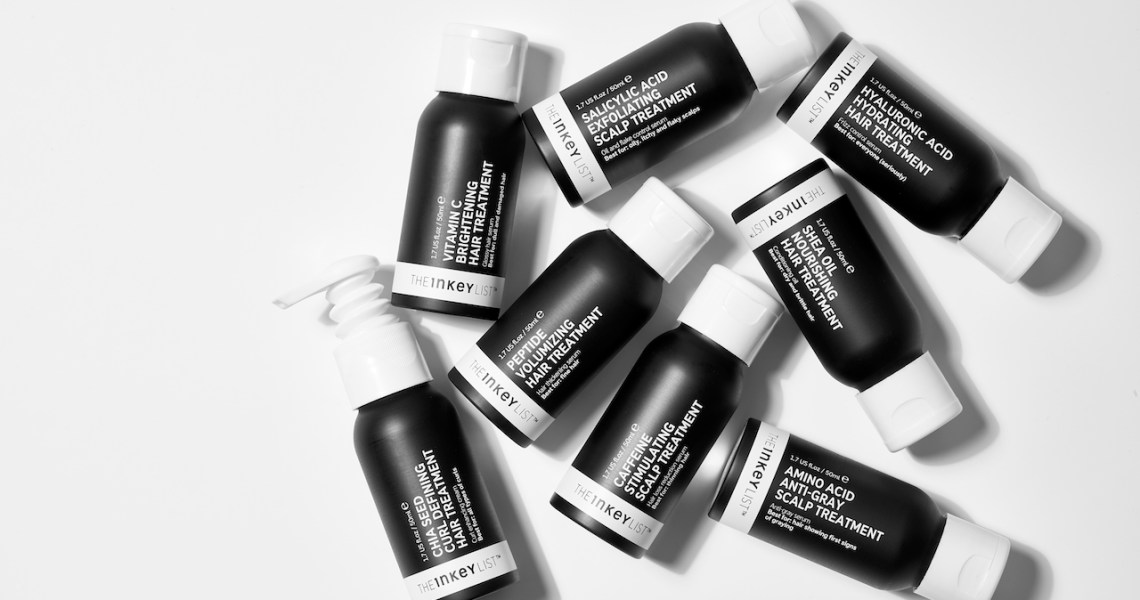With its ingredient-driven focus and affordable price range, cult brand The Inkey List is expanding from face to hair.
Launched in late September on the 2-year-old brand’s site for the U.S. market, The Inkey List’s eight-product hair collection features hair and scalp treatments with ingredients such as caffeine and salicylic acid in a price range of $8-$15. Like the Inkey List’s skin-care lineup, the products are not targeted toward any specific age group or gender, but address specific concerns including hair thinning or frizz.
“The reason that we went into hair was definitely the same ethos as our skin-care regimen,” said Inkey List co-founder and CEO Colette Laxton. This ethos “was really around misinformation and confusion that people had within the skin-care space.”
“People were saying to us ‘Oh, this ingredient, it’s an exfoliant. It’s an acid. Is that good? Is that bad? Should I use it?’” she said. “What was quite interesting is, when we started looking into expanding the hair category, it’s even further behind [than] skin.”
The Inkey List’s accessible, ingredient-driven model of “democratizing” skin care, also popularized by The Ordinary, has been highly successful within the facial skin-care market. The brand’s sales growth rate has doubled in 2020 overall, tripling since the pandemic shutdown began. As “skinification” of hair care takes off, the brand is hoping to do the same with hair care through consumer education.
The key for the category taking off is to influence consumer purchasing habits. The Inkey List’s site features a “recipe builder” quiz for customers to enter their hair type and concerns, in order to receive relevant product recommendations. The quiz is based on the brand’s skin-care recipe builder, which has been used by 800,000 people since it was created in April 2020, according to the brand. Users can take advantage of the site’s live chat feature for product advice, as well. The brand has also been promoting the hair line on its social channels and via skin-care influencers.
The Inkey List started out as an exclusively wholesale brand when it launched its first skin-care products in U.K. retailers in 2018, which was followed by a Sephora-exclusive launch in the U.S. in 2019. But it’s taking a DTC-first approach to its hair products in the U.S. market.
Ad position: web_incontent_pos1
“It was really important for us to launch our own website versus with a retailer, because of that education piece that’s required,” said Laxton. The hair-care line was first launched exclusively in the U.K. on Cult Beauty in July 2020, and has recently expanded to Boots and Selfridges online.
“Fundamentally, the reason why skin care changed is that it was driven by indie brands, and hair care is still very much a major, branded player playground,” said Inkey List co-founder and lead chemist Mark Curry. “It’s only last year probably that [established brands] started to get a bit of a kick in the shins.”
Since Inkey List launched its hair line, scalp-care products have been especially popular and have driven interest among men.
“It definitely is piquing male interest, especially the salicylic acid scalp treatment,” said Laxton. The product, geared toward dandruff, has been the brand’s best seller in hair. “I would definitely say salicylic acid is an ingredient that’s gone crazy anyway, and we can see that with our skin care,” said Curry.
The brand sees high potential for growth, especially as the “skintellectual” contingent grows online. “Less than 20% of Americans and English people use serums in skin care, so you’re talking to a very noisy minority when it comes to actual beauty junkie serums,” said Curry.
Ad position: web_incontent_pos2
And the DTC-led strategy is a new one for the brand. It launched DTC e-commerce in May for the U.K. and in September for the U.S.
“It took us two years to actually get our head around DTC and to get the right people in that could actually help us to do it,” said Laxton. “It’s very backwards from a lot of indie brands. But now we’ve launched our own DTC, and we like seeing the power of that and the control we have in terms of education.”




